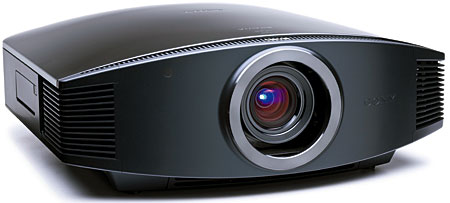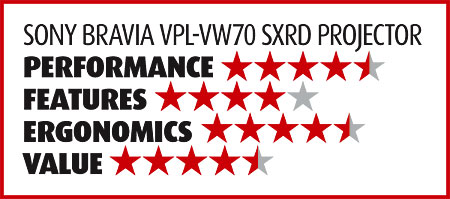Sony BRAVIA VPL-VW70 SXRD Projector Page 2
Sony’s Advanced Iris feature, found in the Cinema Black Pro menu, is now a familiar sight on Sony projectors. It has two dynamic settings, Auto 1 and Auto 2, each with adjustable sensitivity. These open the iris on bright scenes and close it down on dark ones, which results in an impressive dynamic contrast. Like all dynamic irises, it does produce some brightness compression. However, I found the effect to be largely unnoticeable, and the overall operation of the feature was free of visible artifacts. There’s also a 100-step, manually adjustable iris mode.

Screening
The Sony’s 480i-to-1080p video processing was the least impressive of the group, but it was still good. The distinctions between the Sony and the other projectors in the group are unlikely to be visible on most program material. It produced artifacts on one of the 2:2 pulldown tests and on a 3:2 pulldown test of a race car passing an empty set of bleachers multiple times. It had to re-establish lock with each pass (the best processors lock on in the first pass and hold the lock through multiple passes). But apart from those shortcomings, it sailed through the other standard-definition video-processing tests.
 The projector’s 1080i-to-1080p processing was good. However, on one video-based test, I had to change the Film mode’s setting from Auto to Off to eliminate some diagonal jaggies. It isn’t that difficult to change the Film mode setting while you’re viewing a source, but it shouldn’t be necessary.
The projector’s 1080i-to-1080p processing was good. However, on one video-based test, I had to change the Film mode’s setting from Auto to Off to eliminate some diagonal jaggies. It isn’t that difficult to change the Film mode setting while you’re viewing a source, but it shouldn’t be necessary.
The Sony responds properly to above-white and below-black information in the source and produces a pristine 1:1 pixel map.
The pixel alignment, as received, was also good, and I did much of my viewing without recourse to the projector’s Panel Alignment feature. But I did check it out. You must perform the alignment using a built-in crosshatch test pattern. The results on this pattern do not align perfectly with those from an externally generated pattern. This made the procedure a bit tedious, particularly on the 144-point(!) Zone adjustment. But it did work. The Shift option, which affects the entire image at once, is easier to use. But it produces a reddish discoloration in single-pixel-width patterns with even the smallest adjustment. The Zone adjustment did not.
You also don’t want to mess with the Sony’s color. After a good calibration, and in the Normal Color Space setting, the Sony produced the most accurate color of the group. The color gamut in Normal is just a bit undersaturated, which to my mind is better than the oversaturated color gamuts of the other two projectors here. The RCP feature could correct the color points exactly, but it left the colors with incorrect intensities and showed no real improvement.
The Sony’s colors looked consistently right. Greens were not over the top (unless they were shot that way), and rarely did fleshtones come off as either anemic or orange. Groundhog Day is not a particularly impressive Blu-ray Disc, and its fleshtones are all over the map (possibly a result of the original photography). But they appeared more consistently natural on the Sony than on the JVC or the Sanyo.
Please note that, to get the brightness discussed here, I pushed the Contrast setting slightly above its optimum setting. The whites did not clip, but a very pale pink discoloration did appear in the brightest whites of a multistep gray-scale pattern. This never caused any visible problems on real program material, and I found it more acceptable than the loss of brightness that was needed to eliminate it.
The resolution was also superb, though arguably no better than on the other projectors. Nevertheless, the images on Baraka, scanned at 8K from the 70mm film original before it was downconverted to 1,920 by 1,080 for Blu-ray, were astonishing in their detail and depth. True, they also looked great on the Sanyo and, in particular, on the brighter JVC, but that takes nothing away from the Sony’s solid performance.
As delivered, the Sony already had 250 hours on its projection lamp. While it had the lowest measured light output of the group in its Advanced iris settings, it had plenty of punch on my screen. The Sony’s exceptional black level had a lot to do with this. I used an Advanced Iris setting of Auto 2 for most of the test with complete satisfaction. But after I made the contrast ratio measurements, I discovered that the Auto 1 setting offered even deeper blacks. The peak manual iris setting not only offered excellent blacks, but it also increased the light output to nearly 18 foot-lamberts.
All of these settings worked beautifully on my smaller screen, and the brightness and resolution remained impressive on the large-screen test I described in the introduction to this report. However, I’ll confine my remarks here to that 13-ft-L, Auto 2 iris setting, unless otherwise noted. All of my favorite black-level test scenes—the opening star field, night shipboard, and Russian Stargate installation scenes in Stargate: Continuum, the belowdecks scenes in Master and Commander: The Far Side of the World, the bottling plant in The Incredible Hulk, and the shipping crates in Madagascar—came off as well as, or better than, any other projector I’ve tested.
Head to Head: Sony and JVC
The only thing I had left to do was compare the Sony to the JVC DLA-HD350. Both projectors performed beautifully with essentially equal resolution on the smaller and larger screens. Interestingly, the Sony appeared to have more pop in bright scenes, even with the JVC’s higher brightness. But when I tweaked the gamma settings on the JVC a bit, this difference changed from obvious to subtle. The JVC’s blacks were a hair less deep than the Sony’s, but this was hard to spot on most material and not obvious even on the most challenging sources. Both projectors had good shadow detail, but the JVC had more punch in dark, low-contrast scenes. The Sony clearly had better color, but the differences in fleshtones, in particular, were much less obvious than I expected given the measurements.
Conclusion
While it has some significant competition, the Sony more than holds its own. With its gorgeous color, superb blacks, and excellent resolution, there’s no question that it deserves a Top Pick recommendation—and your serious consideration if it fits your budget.

- Log in or register to post comments























































